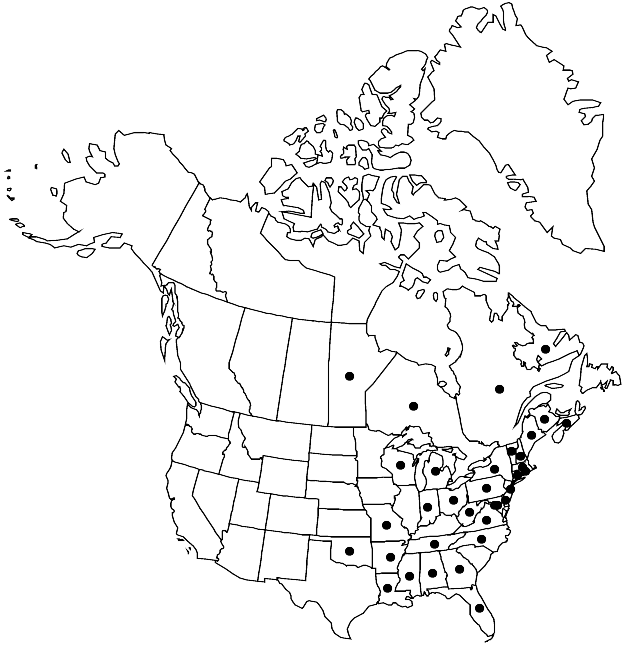Dichelyma capillaceum
Kongl. Vetensk. Acad. Handl. 1832: 278. 1833.
Plants to 20 cm, green to yellowish, brownish at base. Stems with axillary hairs 100–200 µm, basal cell 1, quadrate, distal cells 2 or 3, long-cylindric. Leaves weakly 3-ranked, erect-ascending to weakly falcate, linear-lanceolate, 4–7 mm, medial stem leaves 0.4–0.8 mm wide; margins plane, entire or occasionally serrulate proximally; apex filiform-acuminate; costa long-excurrent; alar cells slightly enlarged; medial laminal cells 60–120 × 6–8 µm. Perichaetia with leaves overtopping capsule. Seta 3–5 mm. Capsule immersed or laterally emergent, oblong-cylindric, 1–2 mm; operculum obliquely long-rostrate, 0.5–1 mm; exostome teeth spiculose-papillose; endostome brownish orange, spiculose-papillose, trellis imperfect. Calyptra 1.5–3 mm. Spores 10–15 µm.
Habitat: Trunks and branches of trees (Acer, Alnus, Carya, Fraxinus, Gleditsia, Liquidambar, Nyssa, Populus, Taxodium, Thuja, Ulmus) and shrubs (Cephalanthus), sticks, roots, rock, boulders along edges of lakes, ponds, streams, seasonally submerged depressions in woods
Elevation: low to moderate elevations (0-400 m)
Distribution

Man., N.B., Nfld. and Labr. (Labr.), N.S., Ont., Que., Ala., Ark., Conn., Del., D.C., Fla., Ga., Ind., La., Maine, Md., Mass., Mich., Miss., Mo., N.H., N.J., N.Y., N.C., Ohio, Okla., Pa., R.I., Tenn., Vt., Va., W.Va., Wis., Europe.
Discussion
Dichelyma capillaceum, the most common and most slender species in Dichelyma, is equally abundant on bark or rock. The species has indistinctly keeled, weakly three-ranked leaves with long-excurrent costae. Dichelyma falcatum and D. pallescens can be separated from D. capillaceum by their larger plants and strongly keeled, distinctly three-ranked, lanceolate leaves. Dichelyma uncinatum is also slender but differs in having strongly secund to circinate leaves, while those of D. capillaceum are erect or spreading. Dichelyma pallescens differs in having acute to obtuse leaf apices.
There is a supposed Newfoundland collection of Dichelyma capillaceum made by Fowler at Grand Lake, Sept. 18, 1879 (NY), which R. Ireland annotated as probably an error for Grand Lakes, New Brunswick. Fowler collected mosses mostly in New Brunswick; there is no indication he collected in Newfoundland. W. H. Welch (1960) reported D. capillaceum from Manitoba (Hand 528, July 20, 1938, near Rennie); this specimen could not be located.
Selected References
None.
